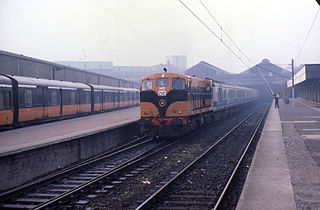
Wagonways, also known as horse-drawn railways and horse-drawn railroad consisted of the horses, equipment and tracks used for hauling wagons, which preceded steam-powered railways. The terms plateway, tramway, dramway, were used. The advantage of wagonways was that far bigger loads could be transported with the same power.

A railroad tie, crosstie, railway tie or railway sleeper is a rectangular support for the rails in railroad tracks. Usually laid perpendicular to the rails, ties transfer loads to the track ballast and subgrade, hold the rails upright and keep them spaced to the correct gauge.

Compagnie de Saint-Gobain S.A. is a French multinational corporation, founded in 1665 in Paris and headquartered on the outskirts of Paris, at La Défense and in Courbevoie. Originally a mirror manufacturer, it also produces a variety of construction, high-performance, and other materials. Saint-Gobain is present in 76 countries and as of 2022 employs more than 170,000 people.
Ferguson plc is a British multinational plumbing and heating products distributor with its head office in Wokingham, England. Its brands include Ferguson Enterprises.
Wolseley UK is a supplier of building materials, with trade customers accounting for the largest proportion of its sales. Wolseley are the largest trade specialist in plumbing and heating in the UK. It has retail showrooms around the United Kingdom which are open to the general public.

Ball Corporation is an American company headquartered in Westminster, Colorado. It is best known for its early production of glass jars, lids, and related products used for home canning. Since its founding in Buffalo, New York, in 1880, when it was known as the Wooden Jacket Can Company, the Ball company has expanded and diversified into other business ventures, including aerospace technology. It eventually became the world's largest manufacturer of recyclable metal beverage and food containers.

Shunting, in railway operations, is the process of sorting items of rolling stock into complete trains, or the reverse. In the United States this activity is known as switching.
Dick, Kerr and Company was a locomotive and tramcar manufacturer based in Kilmarnock, Scotland and Preston, England.

The Hendre-Ddu Tramway was a 1 ft 11 in narrow gauge industrial railway built in 1874 in Mid-Wales to connect the Hendre-Ddu slate quarry to Aberangell station on the Mawddwy Railway. It consisted of a main line 3+1⁄2 miles (5.6 km) long and several branch lines and spurs serving other quarries, local farms and the timber industry.
The Polloc and Govan Railway was an early mineral railway near Glasgow in Scotland, constructed to bring coal and iron from William Dixon's collieries and ironworks to the River Clyde for onward transportation.
Jewson is one of the largest chains of British general builders' merchants, selling to small and medium building contractors. The chain comprises around 500 branches located all across Great Britain. Jewson is part of Denmark's STARK Group.
The Slamannan Railway was an early mineral railway between the north-eastern margin of Airdrie and Causewayend on the Union Canal, near Linlithgow, Scotland.

The Tranent to Cockenzie Waggonway was an early waggonway, possibly the first in Scotland, opened in 1722. It was 2+1⁄2 miles (4 km) miles long and connected coal pits at Tranent with the salt pans at Cockenzie and harbour at Port Seton in East Lothian, Scotland. The track was wooden, and wagons were drawn by horses. The Battle of Prestonpans in 1745 was fought across the line.

Angerstein Wharf is an industrial area and location of a marine construction aggregate and an associated cement facility and freight station in the Port of London, operated by the Cemex company, located on the south bank of the Bugsby's Reach of the River Thames in both Greenwich and Charlton, within the Royal Borough of Greenwich. It has safeguarded wharf status.
The Rutherglen and Coatbridge Railway was a railway line in Scotland built by the Caledonian Railway to shorten the route from the Coatbridge area to Glasgow. It opened in 1865. It was later extended to Airdrie in 1886, competing with the rival North British Railway. Soon after a further extension was built from Airdrie to Calderbank and Newhouse.
National Gypsum Company is a company based in Charlotte, North Carolina, that produces drywall gypsum boards in the US. It has 17 gypsum board plants in the US and presents itself as a fully integrated building products manufacturer. It is a private company, incorporated as New NGC, Inc. in 1993 after previously filing for Chapter 11 bankruptcy in 1990. It is one of the six producers which hold approximately 81% of the worldwide wallboard market
Hammond Lumber Company was a logging and resource extraction company operating in Humboldt County, CA.
Several mineral railways were constructed around Dunfermline in western Fife, Scotland, in the eighteenth century and later. Their purpose was to convey minerals to market from the outcropping coal deposits that had encouraged industrial activity in the area from an early date.
Herman Finger (1856-1929) was a lumberman who owned and operated various lumber companies that operated in Wisconsin, Minnesota, Ontario, Manitoba, and Saskatchewan. He also served as the first mayor of The Pas after its establishment in 1912.

The Clay Cross Company was founded as George Stephenson and Co. in 1837 by the railway pioneer, George Stephenson. The company established coal mines, ironworks, brickworks and pipe factories at Clay Cross near Chesterfield. The company was closed in 1998.











